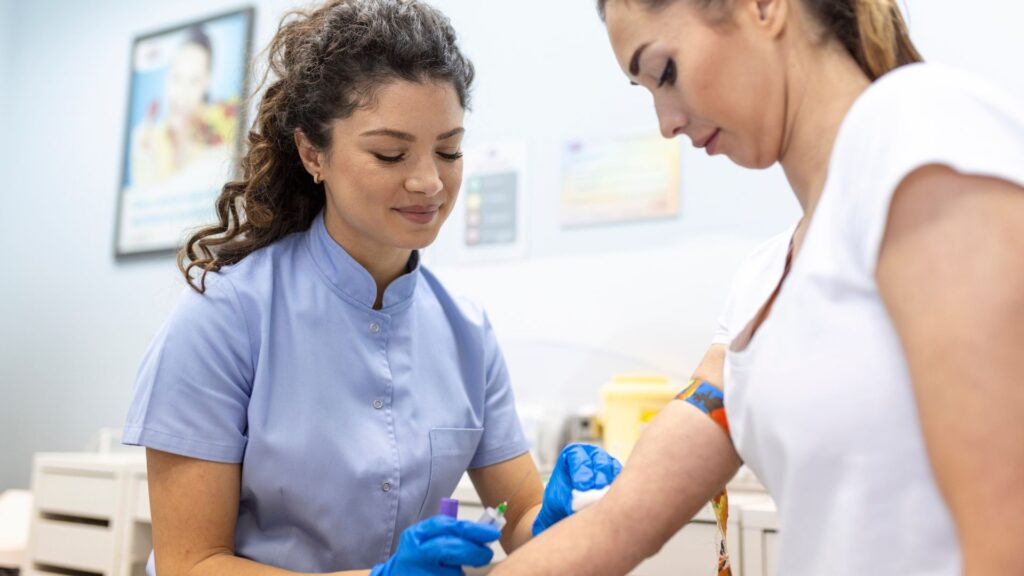In the evolving world of wellness and alternative healthcare, many clinics and med spas are exploring the scope of what their team members can do. Many wellness providers wonder whether phlebotomists are permitted to start infusions or deliver IV therapy in clinical settings.
This article provides a complete guide to the scope of practice for phlebotomists, the legal and clinical considerations, and the certification paths required to perform intravenous therapy safely and legally.
Understanding the Role of a Phlebotomist
A phlebotomist is a medical professional trained to draw blood through venipuncture. Their primary role is typically limited to collecting blood samples for diagnostic testing, blood donations, or transfusions.
Certified phlebotomists can work in a variety of healthcare environments, including hospitals, diagnostic labs, and med spas. They may also assist with specimen labeling, patient identification, and maintaining equipment sanitation.
While phlebotomy involves locating and puncturing veins—a skill also required for IV insertion—the scope of practice for phlebotomists is narrower than that of nurses or IV therapists. Most of them can only draw blood, not administer fluids or medications through a catheter line. This distinction is crucial for businesses that offer these types of services, especially for those planning to open a med spa where infusion treatments are becoming increasingly popular.
Phlebotomist Scope of Practice and Limitations
What phlebotomists are legally allowed to do is determined by the state in which they work and the specific training they receive. In many states, they are not permitted to initiate fluid access or perform vein cannulation unless they have undergone training and certification.
Phlebotomists cannot perform these tasks without proof of healthcare training and specialized insertion credentials. Some states allow them to engage in these procedures under direct supervision, while others prohibit them altogether. It is essential for med spa owners and wellness providers to review local guidelines to understand what phlebotomists can and cannot do within their practice.
Even when states allow participation in infusion procedures, further certification in intravenous care or cannulation is typically required. This often involves completing an accredited skills course and gaining hands-on practice under the supervision of a registered nurse (RN) or licensed practical nurse (LPN).

Training and Certification Requirements
To perform these procedures, phlebotomists must undergo additional training beyond standard phlebotomy programs. This includes a specialized certification course, which provides education on catheter placement, line management, and fluid administration. The training may also include anatomy, vein selection, and emergency response protocols.
Phlebotomy training programs may touch on venipuncture and patient care, but they rarely include the depth required for advanced vascular access unless specifically designed to do so. Becoming certified typically requires:
- Enrolling in an accredited IV certification training course
- Completing hands-on IV insertion training and insertion practice
- Passing a final exam or skills assessment
Once certified, a phlebotomy technician may be qualified to start IVs if permitted under their state’s clinical practice regulations.
IV Therapy in Med Spas: Who Can Administer It?
Within a wellness or med spa setting, IV therapy is one of the popular services for hydration, detox, and nutrient delivery. However, only certified professionals are permitted to administer these treatments. In most cases, this includes registered nurses (RNs), licensed practical nurses (LPNs), or certified medical assistants with relevant training.
While phlebotomists bring valuable venipuncture skills, they cannot start IV therapy unless they’ve obtained additional training. Even in states that allow phlebotomists to start an IV, they must demonstrate competency and have proof of health care training from an accredited program.
Employers must remain compliant with state regulations and prioritize client safety. Working with properly trained and certified professionals helps ensure that catheter placement and fluid delivery are safe, effective, and legally authorized.
Final Thoughts from INNERGY Dev
While phlebotomists are highly trained in drawing blood, they cannot perform IV therapy without additional training and certification. Regulations vary by state, but the standard of care remains high when it comes to IV insertion and infusion.
At INNERGY Dev, we support med spas and wellness providers with advanced wellness technologies that complement IV therapy services. We design our systems with the understanding that only qualified healthcare providers—those who meet the scope of practice in their state—should oversee infusion administration. Always ensure your team is properly equipped, trained, and compliant before offering these treatments.

